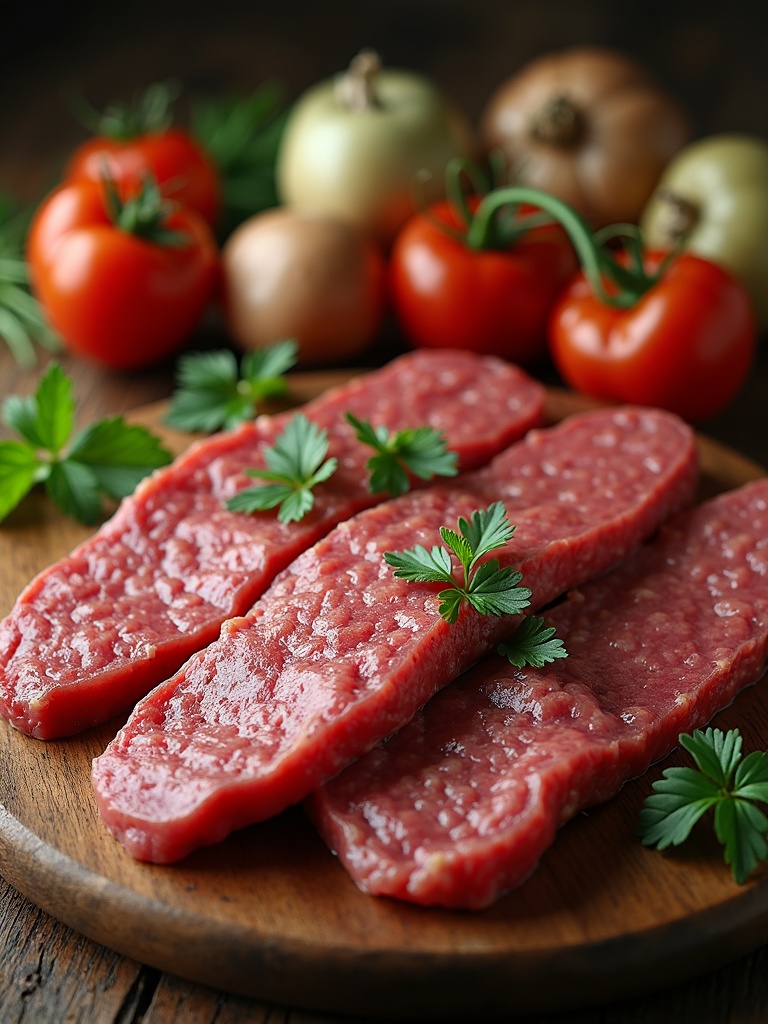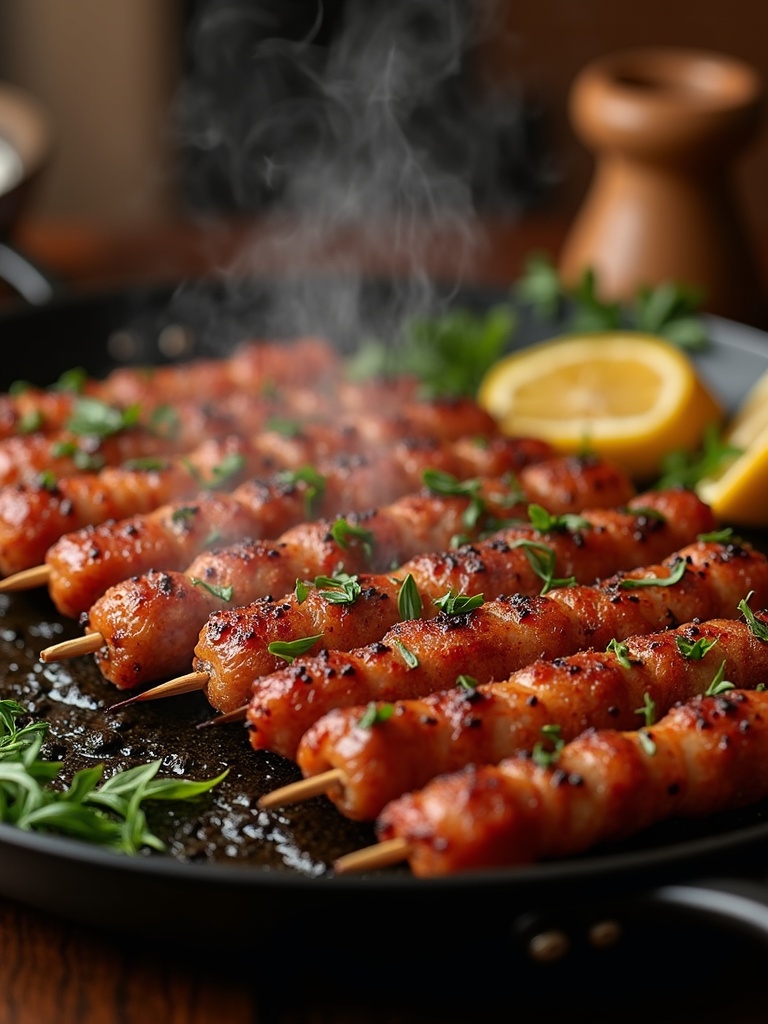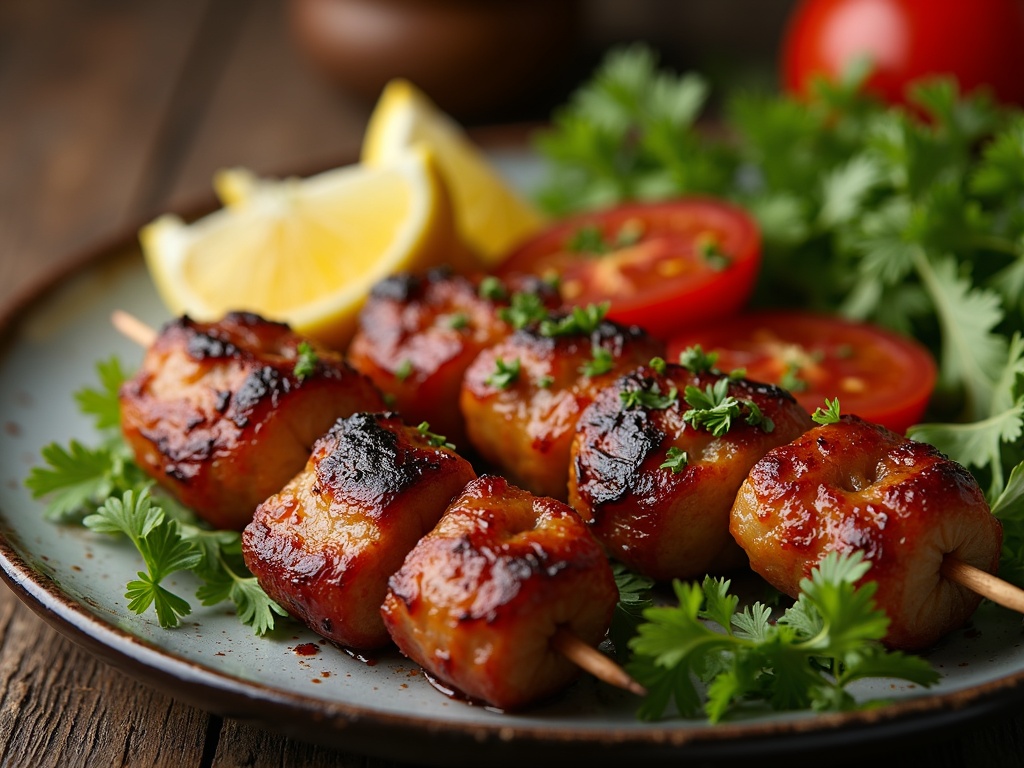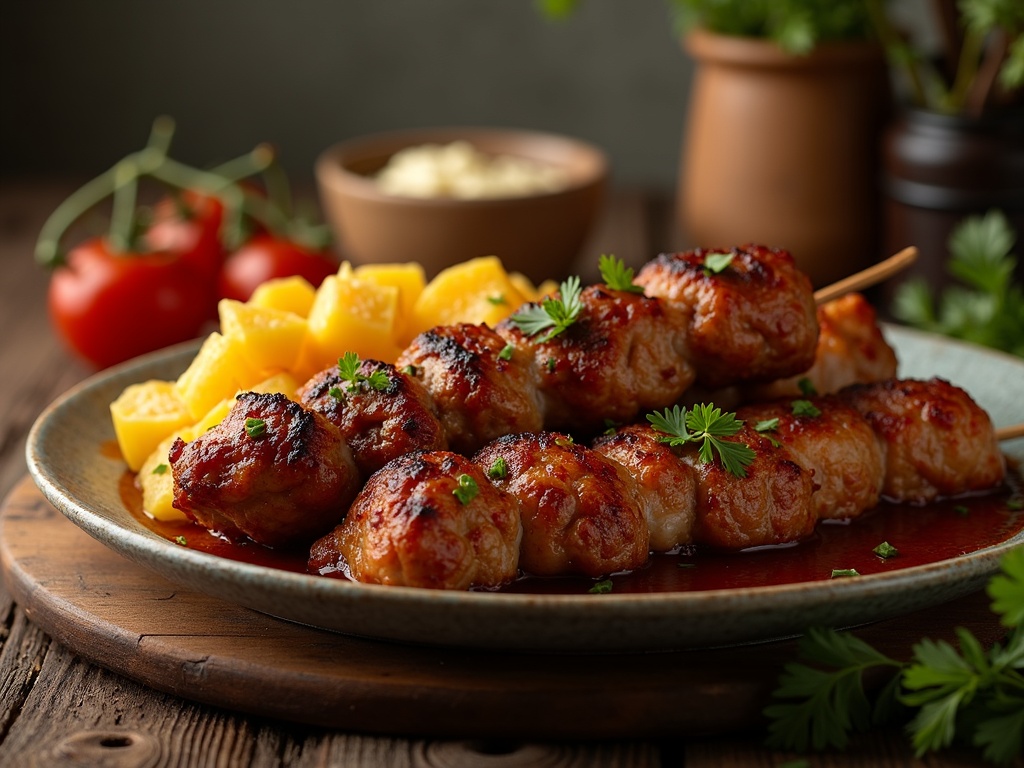Introduction
Indulge in the rich and aromatic world of turkish kebab, a culinary masterpiece that has captivated food enthusiasts across the globe. With origins tracing back to ancient times, these flame-kissed meat delicacies have evolved into countless varieties while maintaining their authentic charm.
Unlike simple meat preparations like juicy smash burgers, turkish kebab involves intricate spice blends and marination techniques that have been perfected over centuries.
Table of Contents
Ingredients You Will Need

For authentic turkish kebab, you’ll need quality ingredients that work harmoniously to create that distinctive flavor profile. The foundation of any great kebab lies in its meat and spice mixture:
- 2 pounds (900g) of lamb shoulder or a mixture of lamb and beef (80/20 ratio), finely minced
- 1 medium onion, very finely grated
- 4 cloves of garlic, minced
- 2 tablespoons of tomato paste
- 1 tablespoon of red pepper paste
- 2 teaspoons of ground cumin
- 2 teaspoons of ground coriander
- 2 teaspoons of Aleppo pepper (or paprika with a pinch of cayenne)
- 1 teaspoon of sumac
- 1 teaspoon of dried oregano
- 1 tablespoon of freshly chopped parsley
- 1 teaspoon of salt
- 1/2 teaspoon of freshly ground black pepper
- 2 tablespoons of ice-cold water
For the traditional serving elements:
- Thin lavash or pita bread
- Fresh tomatoes, sliced
- Onions, thinly sliced and sprinkled with sumac
- Fresh parsley and mint leaves
- Grilled green chilies or bell peppers
- Yogurt-garlic sauce (combine 1 cup Greek yogurt with 2 minced garlic cloves and salt)
If you can’t find lamb, you can substitute with quality ground beef, though the flavor profile will change slightly. The key is selecting meat with about 20% fat content for juiciness and flavor – similar to what you’d use for homemade meatball sliders. For those who prefer a milder taste, you can adjust the amount of Aleppo pepper and garlic to suit your palate.
Timing
Creating authentic turkish kebab requires patience, but the results are well worth the time investment:
Preparation Time: 30 minutes (plus 4 hours or overnight marination)
This includes mincing the meat (if not already ground), preparing the spice mix, and forming the kebabs. This preparation time is slightly longer than what you’d expect for basic ground beef dishes, but the complex flavors developed are incomparable.
Cooking Time: 15-20 minutes
The actual grilling is relatively quick compared to the preparation, similar to how Mongolian beef cooks rapidly once all preparations are complete.
Total Time: Approximately 5 hours (including marination)
While this might seem long, most of it is passive resting time that allows the flavors to develop fully. The active cooking time is minimal, making this an efficient meal option despite its gourmet results.
Step-by-Step Instructions

Step 1: Prepare the Meat Mixture
Begin by finely mincing the meat if it’s not already ground. Traditional turkish kebab requires meat that’s processed to a paste-like consistency. In a large bowl, combine the minced meat with the grated onion, ensuring it’s very finely grated to release its juices. Add the minced garlic and mix thoroughly. Unlike quick beef stir-fry dishes, kebab requires thorough mixing to create the right texture.
Step 2: Add the Seasonings
Incorporate the tomato paste, red pepper paste, cumin, coriander, Aleppo pepper, sumac, oregano, and chopped parsley into the meat mixture. Add salt and black pepper, then pour in the ice-cold water. The cold water helps bind the mixture and keeps the fat from melting too quickly during cooking, resulting in juicier kebabs.
Step 3: Knead the Mixture
Using your hands, knead the meat mixture for at least 5-7 minutes until it becomes sticky and paste-like. This step is crucial for authentic turkish kebab as it creates the distinctive texture that holds together on the skewer. The mixture should feel slightly tacky to the touch.
Step 4: Rest and Marinate
Cover the bowl with plastic wrap and refrigerate for at least 4 hours, preferably overnight. This resting period allows the flavors to meld and the proteins in the meat to relax, resulting in a more flavorful and tender kebab. This marination technique differs significantly from quicker recipes like smash burgers where immediate cooking is preferred.
Step 5: Shape the Kebabs
Remove the mixture from the refrigerator and let it sit at room temperature for about 30 minutes. Wet your hands with cold water (this prevents sticking) and take a portion of the meat mixture. For Adana-style kebabs, mold the mixture around a wide, flat skewer, pressing to create a long, flat shape about 1/2 inch thick. For Shish kebab, form the meat into oblong balls and thread them onto round skewers.
Step 6: Prepare for Grilling
Preheat your grill to high heat (about 450°F/230°C). Traditional turkish kebab is cooked over charcoal for an authentic smoky flavor, but a gas grill or even a very hot cast-iron griddle can work well too. If using a grill, make sure the grates are clean and lightly oiled to prevent sticking.
Step 7: Grill the Kebabs
Place the skewers on the hot grill, being careful not to overcrowd them. Grill for about 3-4 minutes on each side, turning only once to get a nice char without drying out the meat. Unlike some recipes that call for constant turning, turkish kebab benefits from fewer flips to develop a proper crust while maintaining juiciness inside.
Step 8: Rest Before Serving
Remove the kebabs from the heat and let them rest for 2-3 minutes. This allows the juices to redistribute throughout the meat, ensuring each bite is moist and flavorful. During this time, you can quickly warm your lavash or pita bread on the grill.

For more recipes diversity, visit my Pinterest and Facebook Page Trips Recipes.
Nutritional Information
Understanding the nutritional profile of turkish kebab helps you make informed dietary choices:
- Calories: Approximately 320 per serving (5 oz portion without sides)
- Protein: 28g – providing essential amino acids for muscle maintenance
- Fat: 22g – primarily from the meat, with saturated fat around 9g
- Carbohydrates: 3g – making it suitable for low-carb diets
- Fiber: 1g – minimal, coming from the spices and herbs
- Sodium: 580mg – moderate, primarily from added salt
- Cholesterol: 95mg – typical for red meat dishes
- Iron: 3.5mg – meeting about 20% of daily requirements
- Zinc: 5.2mg – supporting immune function
- B vitamins: Rich source, particularly B12 for nerve function
These values vary depending on the exact meat ratio and preparation methods. When served with traditional sides, the complete meal offers a balanced protein-rich option that aligns with Mediterranean diet principles.
Healthier Alternatives for the Recipe
Turkish kebab can be adapted to suit various dietary needs while maintaining its authentic flavors:
- Substitute lamb with turkey or chicken thigh meat for a leaner protein option that cuts fat content by nearly 40%
- Use a 50/50 blend of meat and finely chopped mushrooms to reduce calories while maintaining texture
- Replace some of the meat with grated zucchini or eggplant for added fiber and reduced calorie density
- Skip the bread wrapper and serve over a bed of bulgur wheat or brown rice for more complex carbohydrates
- Use a yogurt-based marinade with less oil to reduce overall fat content while tenderizing the meat
- Opt for baking on a rack at 425°F instead of grilling, allowing fat to drip away during cooking
- Increase the herb content (mint, parsley, and dill) to boost flavor without adding calories or sodium
- Serve with a side of grilled vegetables rather than rice or bread for a lower-carb meal option
- Use a spritzer bottle with olive oil rather than basting for controlled fat addition
These modifications can reduce calories by up to 30% while preserving the essential character of turkish kebab.
Serving Suggestions
Elevate your turkish kebab experience with these traditional and creative serving ideas:
- Wrap in warm, thin lavash bread with sliced tomatoes, onions, and a dollop of garlic yogurt sauce for an authentic street-food experience
- Serve over fragrant rice pilaf studded with pine nuts and dried fruits for a festive meal presentation
- Create a turkish kebab platter with assorted grilled vegetables, hummus, and warm pita wedges for family-style dining
- Offer as part of a mezze spread alongside baba ganoush, tzatziki, and stuffed grape leaves for an impressive appetizer selection
- Serve atop a fresh shepherd’s salad (chopped tomatoes, cucumbers, peppers) dressed with olive oil and lemon for a lighter option
- Use as a protein addition to grain bowls featuring bulgur, quinoa, or couscous with roasted vegetables
- Incorporate leftover kebab meat into morning egg dishes for a savory Turkish-inspired breakfast
- Serve alongside grilled halloumi cheese with a drizzle of pomegranate molasses for a sweet-savory contrast
- Present on skewers over a bed of sumac-dusted onions with grilled tomatoes and peppers for visual appeal
These serving suggestions showcase the versatility of turkish kebab while honoring its rich cultural heritage.
Common Mistakes to Avoid
Master the art of perfect turkish kebab by avoiding these typical pitfalls:
- Selecting meat that’s too lean, which results in dry kebabs – aim for 20% fat content for optimal juiciness
- Skipping the kneading process, which is essential for developing the protein structure that gives kebabs their distinctive texture
- Not chilling the meat mixture adequately before forming, making it difficult to shape and more likely to fall off skewers
- Over-handling the meat with warm hands, which melts the fat prematurely – work quickly with cold, wet hands
- Using skewers that are too thin, causing the meat to rotate when turned – wide, flat metal skewers work best
- Cooking at too low temperature, which causes the meat to release moisture and become dry rather than searing quickly
- Pressing the kebabs during cooking, which squeezes out valuable juices – trust the process and resist the urge to flatten
- Overcooking beyond medium doneness (155°F internal temperature), resulting in tough, dry meat
- Neglecting the resting period after cooking, which allows juices to redistribute throughout the meat
- Using pre-ground spices that have lost their potency – toasting and grinding whole spices provides superior flavor
Understanding these common errors will help you create turkish kebab with authentic texture and flavor every time.
Storing Tips for the Recipe
Maximize the shelf life and maintain the quality of your turkish kebab with these storage recommendations:
- Refrigerate uncooked meat mixture for up to 24 hours in an airtight container – any longer risks spoilage and texture changes
- Store cooked kebab meat in the refrigerator for 3-4 days in a sealed container, separating layers with parchment paper
- Freeze raw kebab mixture for up to 3 months by wrapping portions tightly in plastic wrap, then placing in freezer bags
- Thaw frozen raw mixture slowly in the refrigerator overnight rather than at room temperature for food safety
- Pre-shape kebabs and freeze them on a baking sheet before transferring to freezer bags for convenient single portions
- Reheat leftover turkish kebab in a covered pan with a splash of water to create steam and prevent drying
- Store accompanying sauces separately from the meat to prevent sogginess and extend shelf life
- Freeze cooked kebab meat separated from bread or sides for best texture upon reheating
- Revive refrigerated kebab by briefly heating in a hot skillet rather than microwave to maintain texture
- Use leftover kebab within two months of freezing for optimal flavor and texture
Proper storage ensures you can enjoy homemade turkish kebab conveniently while minimizing food waste.
Conclusion
The journey through making authentic turkish kebab reveals not just a recipe, but a cultural tradition steeped in history and technique. From selecting the right meat blend to mastering the distinctive kneading process, each step contributes to creating that perfect balance of flavor, texture, and aroma that makes turkish kebab so beloved worldwide. Whether you’ve opted for the spicy Adana style or the classic Shish kebab, you’ve now acquired the skills to bring this Turkish street food favorite into your home kitchen with confidence.
The beauty of turkish kebab lies in its adaptability – it can be an impressive centerpiece for special gatherings or a satisfying weeknight dinner when prepared in advance. The techniques you’ve learned here transfer well to other meat preparations, enhancing your overall cooking repertoire. I encourage you to experiment with the spice levels and serving suggestions to make this recipe uniquely your own.
Remember, the key to exceptional turkish kebab is patience during preparation and respect for the traditional methods. Your efforts will be rewarded with an authentic taste experience that transports you straight to the vibrant streets of Istanbul with every bite. Give this recipe a try, and don’t forget to share your kebab creations with friends and family – food tastes better when shared!
FAQs
What is the difference between Adana and Shish kebab?
Adana kebab is made with ground meat (usually lamb) mixed with spices and shaped onto wide, flat skewers, while Shish kebab features chunks of marinated meat (often lamb, chicken, or beef) threaded onto round skewers. Adana is known for its spicier profile with distinctive red color from pepper paste.
Can I make turkish kebab without a grill?
Yes! While traditional turkish kebab is grilled over charcoal, you can achieve excellent results using a cast-iron skillet, broiler, or even an electric grill. The key is high heat to sear the outside quickly while keeping the inside juicy.
Why is my kebab falling off the skewer?
This typically happens when the meat mixture isn’t kneaded enough, the fat content is too low, or the mixture wasn’t chilled adequately before forming. Ensure you knead for 5-7 minutes until sticky, use meat with about 20% fat, and refrigerate the mixture before shaping.
What’s the best meat to use for authentic turkish kebab?
Traditional turkish kebab uses lamb or a lamb-beef mixture (80/20 ratio). The ideal cut for lamb is shoulder meat due to its fat content and flavor. If using beef, chuck with additional fat works well. Always ensure the meat is freshly ground for best texture.
Can turkish kebab be prepared in advance?
Absolutely! You can prepare the meat mixture up to 24 hours in advance and keep it refrigerated. In fact, longer marination enhances the flavors. You can also shape the kebabs a few hours before cooking and keep them covered in the refrigerator.
What are the traditional accompaniments for turkish kebab?
Authentic turkish kebab is typically served with thin lavash bread, sumac-sprinkled onions, grilled tomatoes and peppers, fresh herbs (parsley, mint), and yogurt-based sauces like cacık or tzatziki. Bulgur pilaf or rice often accompanies the meat as well.

Turkish Kebab
- Total Time: PT5H
- Yield: 6 servings
- Diet: Halal
Description
Authentic Turkish kebab with perfectly spiced ground lamb or beef, grilled to perfection and served with traditional accompaniments.
Ingredients
-
- 2 pounds (900g) of lamb shoulder or a mixture of lamb and beef (80/20 ratio), finely minced
-
- 1 medium onion, very finely grated
-
- 4 cloves of garlic, minced
-
- 2 tablespoons of tomato paste
-
- 1 tablespoon of red pepper paste
-
- 2 teaspoons of ground cumin
-
- 2 teaspoons of ground coriander
-
- 2 teaspoons of Aleppo pepper (or paprika with a pinch of cayenne)
-
- 1 teaspoon of sumac
-
- 1 teaspoon of dried oregano
-
- 1 tablespoon of freshly chopped parsley
-
- 1 teaspoon of salt
-
- 1/2 teaspoon of freshly ground black pepper
-
- 2 tablespoons of ice-cold water
For the traditional serving elements:
-
- Thin lavash or pita bread
-
- Fresh tomatoes, sliced
-
- Onions, thinly sliced and sprinkled with sumac
-
- Fresh parsley and mint leaves
-
- Grilled green chilies or bell peppers
-
- Yogurt-garlic sauce (combine 1 cup Greek yogurt with 2 minced garlic cloves and salt)
Instructions
1. Finely mince the meat if not already ground. Mix with grated onion and minced garlic in a large bowl until well combined, aiming for a smooth, paste-like texture.
2. Add tomato paste, red pepper paste, cumin, coriander, Aleppo pepper, sumac, oregano, chopped parsley, salt, pepper, and ice-cold water. Mix until evenly incorporated.
3. Knead the mixture by hand for 5–7 minutes until it becomes sticky and cohesive. The consistency should be slightly tacky and able to hold shape on a skewer.
4. Cover and refrigerate the meat mixture for at least 4 hours or overnight to allow the flavors to meld and the texture to develop.
5. Bring the mixture to room temperature for 30 minutes. Wet hands with cold water, then shape the mixture around flat skewers (for Adana) or into oblong balls on round skewers (for Shish).
6. Preheat grill to high heat (about 450°F/230°C). Use charcoal for smokiness if possible, or a gas grill or hot cast-iron griddle. Clean and oil the grates to prevent sticking.
7. Grill kebabs for 3–4 minutes per side, flipping only once to create a charred crust and maintain juiciness.
8. Let the kebabs rest for 2–3 minutes before serving. Warm lavash or pita on the grill during this time for the perfect pairing.
Notes
This recipe captures the essence of Turkish street food with carefully balanced spices and authentic preparation methods.
- Prep Time: PT30M
- Cook Time: PT20M
- Category: Main Course
- Method: Grilling
- Cuisine: Turkish

